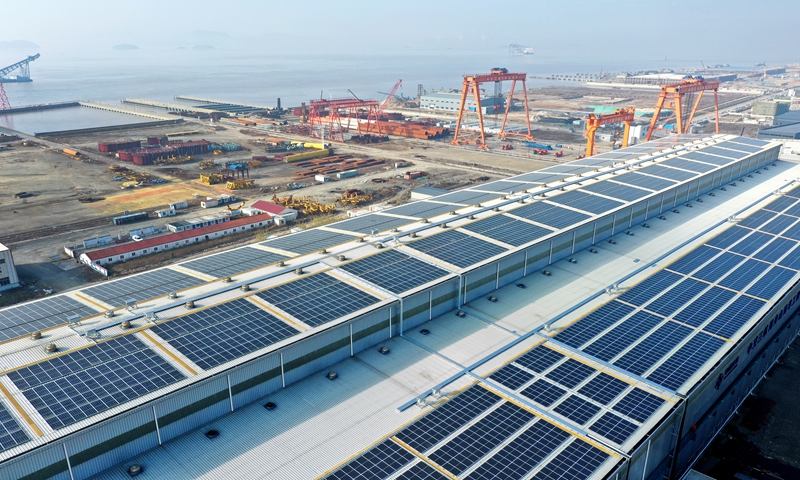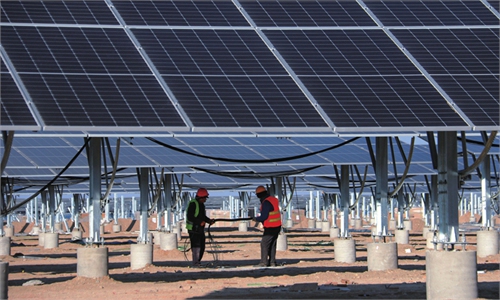
Employees of an electric power company install photovoltaic panels on the roof of a factory in Daishan county, East China's Zhejiang Province, on January 4, 2022. The distributed solar power project, covering an area of 19,580 square meters, can provide 1.62 million kilowatt-hours of electricity annually, saving about 654.64 tons of standard coal and reducing 1,283.4 tons of carbon emissions. Photo: VCG
China's Ministry of Commerce (MOFCOM) has slammed the US government for extending tariffs on imported solar products, saying such a move distorts the global trade order for new-energy products.
In a statement, an official with the MOFCOM noted multiple restrictive measures imposed by the US on solar products over the past decade and called on the US to take concrete actions to jointly respond to climate change and promote global free trade.
The statement came after the US government announced on Friday the extension of Section 201 tariffs on solar cells and modules for another four years. The tariffs had been set to expire on Sunday.
The US' extension of Section 201 measures, despite strong opposition from stakeholders at home and abroad, will not help the sustainable development of the US solar industry, and also distorts the normal international trade order of the photovoltaic sector as a new-energy product, said the official from the MOFCOM's Trade Remedy and Investigation Bureau.
In January 2018, then US President Donald Trump approved tariffs on imported solar cells and modules. The initial tariffs stood at 30 percent, which would decline to 15 percent in the final year of the four-year period.
Chinese experts said that the tariffs have done little to boost the US' solar product manufacturing sector in the past four years.
Even with the added tariffs, Chinese solar products sold in the US are still much cheaper than those made in the US, Lin Boqiang, director of the China Center for Energy Economics Research at Xiamen University, told the Global Times on Sunday.
Energy research firm Wood Mackenzie noted that solar modules used in US solar projects are 55 percent more expensive than those in European projects due to layers of tariffs.
"Trade protectionism is not going to end well. Development depends on competition," Lin said.
The US' decision comes amid headwinds for the industry, including rising raw material costs and supply chain bottlenecks, and it would disturb the industry chain and global efforts to cope with climate change, Lin said.
In the face of US trade protectionism, Chinese enterprises could turn to other emerging markets, including Africa and countries along the routes of the Belt and Road Initiative, Lin added.
Photovoltaic products are important clean-energy products and are of great significance in achieving greenhouse emissions reduction targets.
China is a global leader in photovoltaic product manufacturing. As of the end of 2021, China's installed solar power capacity was about 310 million kilowatts, up 20.9 percent year-on-year, according to the National Energy Administration.
China will continue to work with other countries in the spirit of cooperation to promote low emissions and sustainable economic development, the MOFCOM official said.
The official urged the US to take actions to jointly address climate change, promote global free trade, uphold the multilateral trading system, facilitate free trade in new-energy products, and contribute to global low carbon emissions and the common well-being of mankind.
Global Times

